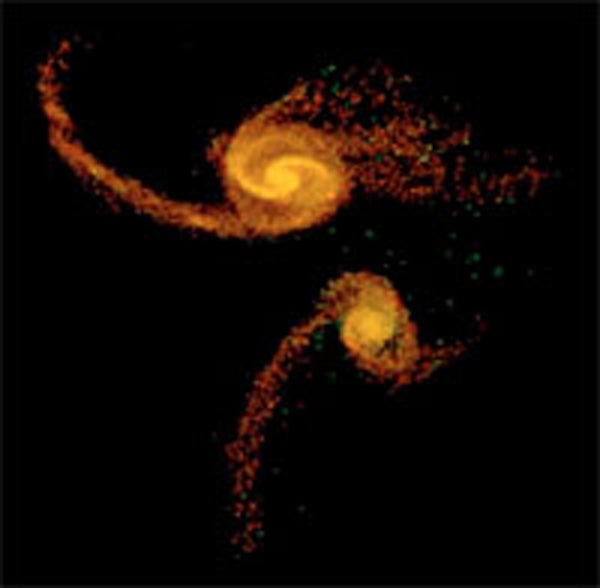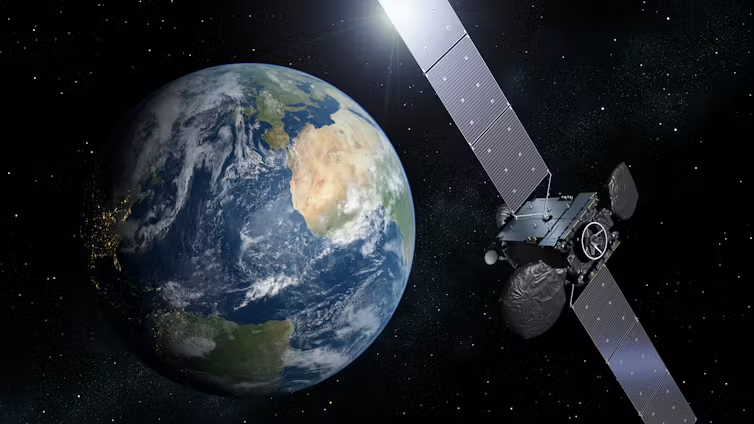Our neighborhood, the Local Group, includes nearly 40 galaxies, and it is dominated by two giant spiral galaxies — Andromeda and our own galaxy, the Milky Way. Many astronomers believe that Andromeda may have formed through the merger of two galaxies of smaller mass. When did such a major event occur, and what are the consequences to our neighborhood? The team led by Francois Hammer from the Paris Observatory, which includes researchers from NAOC, modeled for the first time the detailed structural evolution of the Andromeda Galaxy. They were able to reproduce most of the peculiar properties of this galaxy — the large thin disk including its giant ring of gas and dust, the massive central bulge, the gigantic thick disk, the giant stream of old stars, as well as many other stellar streams discovered in the galaxy halo. They concluded that Andromeda might well be the result of the collision between two galaxies, one slightly more massive than the Milky Way, the other about 3 times less massive. The epoch of the event can be estimated from the observed stellar ages of the Andromeda structures — the first passage and the final fusion had occurred slightly less than 9 and 5.5 billion years ago, respectively.
The birth of the Andromeda Galaxy
Such a collision would be the most important event that ever occurred in the Local Group history. This is because the Andromeda Galaxy and its satellites gather the largest fraction of the baryonic matter of the Local Group that includes gas and stars. The collision must be particularly violent to generate a large enough amount of angular momentum (rotation) that is required to form the giant galactic disk of Andromeda. Simulations also predict that an amount of mass equivalent to one-third that of the Milky Way could have been expelled during the interaction through the formation of gigantic tidal tails. Gas is expected to dominate most of the matter. A large part of this matter is ejected in a privileged direction, including in a hyperplane oriented along the disk of the Andromeda Galaxy. Because the Andromeda disk is seen almost edge-on (inclination of 77°), this hyperplane may easily include the Milky Way.
The origin of the Magellanic Clouds
In the second part of their study, the researchers investigated the possible consequences of such a major event in the immediate neighborhood of our galaxy. The origin of the Magellanic Clouds is indeed still a mystery. They proposed that they formed within one of the tidal tails produced during the gigantic interaction 9 billion years ago. As such, they would have been ejected toward the Milky Way, at a large velocity that has been recently re-evaluated to be 620,000 mph (1 million km/h). This scenario may also explain why the Magellanic Clouds are the only gas-rich and irregular companions of the Milky Way. The researchers used the measured peculiar velocities of these galaxies to trace back their position several billion years ago, and they found many solutions for which they could originate from the Andromeda Galaxy.
If confirmed, these results may have important consequences in cosmology by supporting both the hypothesis that mergers, and the prediction that many dwarf galaxies have formed most spiral galaxies may originate from tidal tails during such events.
Our neighborhood, the Local Group, includes nearly 40 galaxies, and it is dominated by two giant spiral galaxies — Andromeda and our own galaxy, the Milky Way. Many astronomers believe that Andromeda may have formed through the merger of two galaxies of smaller mass. When did such a major event occur, and what are the consequences to our neighborhood? The team led by Francois Hammer from the Paris Observatory, which includes researchers from NAOC, modeled for the first time the detailed structural evolution of the Andromeda Galaxy. They were able to reproduce most of the peculiar properties of this galaxy — the large thin disk including its giant ring of gas and dust, the massive central bulge, the gigantic thick disk, the giant stream of old stars, as well as many other stellar streams discovered in the galaxy halo. They concluded that Andromeda might well be the result of the collision between two galaxies, one slightly more massive than the Milky Way, the other about 3 times less massive. The epoch of the event can be estimated from the observed stellar ages of the Andromeda structures — the first passage and the final fusion had occurred slightly less than 9 and 5.5 billion years ago, respectively.
The birth of the Andromeda Galaxy
Such a collision would be the most important event that ever occurred in the Local Group history. This is because the Andromeda Galaxy and its satellites gather the largest fraction of the baryonic matter of the Local Group that includes gas and stars. The collision must be particularly violent to generate a large enough amount of angular momentum (rotation) that is required to form the giant galactic disk of Andromeda. Simulations also predict that an amount of mass equivalent to one-third that of the Milky Way could have been expelled during the interaction through the formation of gigantic tidal tails. Gas is expected to dominate most of the matter. A large part of this matter is ejected in a privileged direction, including in a hyperplane oriented along the disk of the Andromeda Galaxy. Because the Andromeda disk is seen almost edge-on (inclination of 77°), this hyperplane may easily include the Milky Way.
The origin of the Magellanic Clouds
In the second part of their study, the researchers investigated the possible consequences of such a major event in the immediate neighborhood of our galaxy. The origin of the Magellanic Clouds is indeed still a mystery. They proposed that they formed within one of the tidal tails produced during the gigantic interaction 9 billion years ago. As such, they would have been ejected toward the Milky Way, at a large velocity that has been recently re-evaluated to be 620,000 mph (1 million km/h). This scenario may also explain why the Magellanic Clouds are the only gas-rich and irregular companions of the Milky Way. The researchers used the measured peculiar velocities of these galaxies to trace back their position several billion years ago, and they found many solutions for which they could originate from the Andromeda Galaxy.
If confirmed, these results may have important consequences in cosmology by supporting both the hypothesis that mergers, and the prediction that many dwarf galaxies have formed most spiral galaxies may originate from tidal tails during such events.










